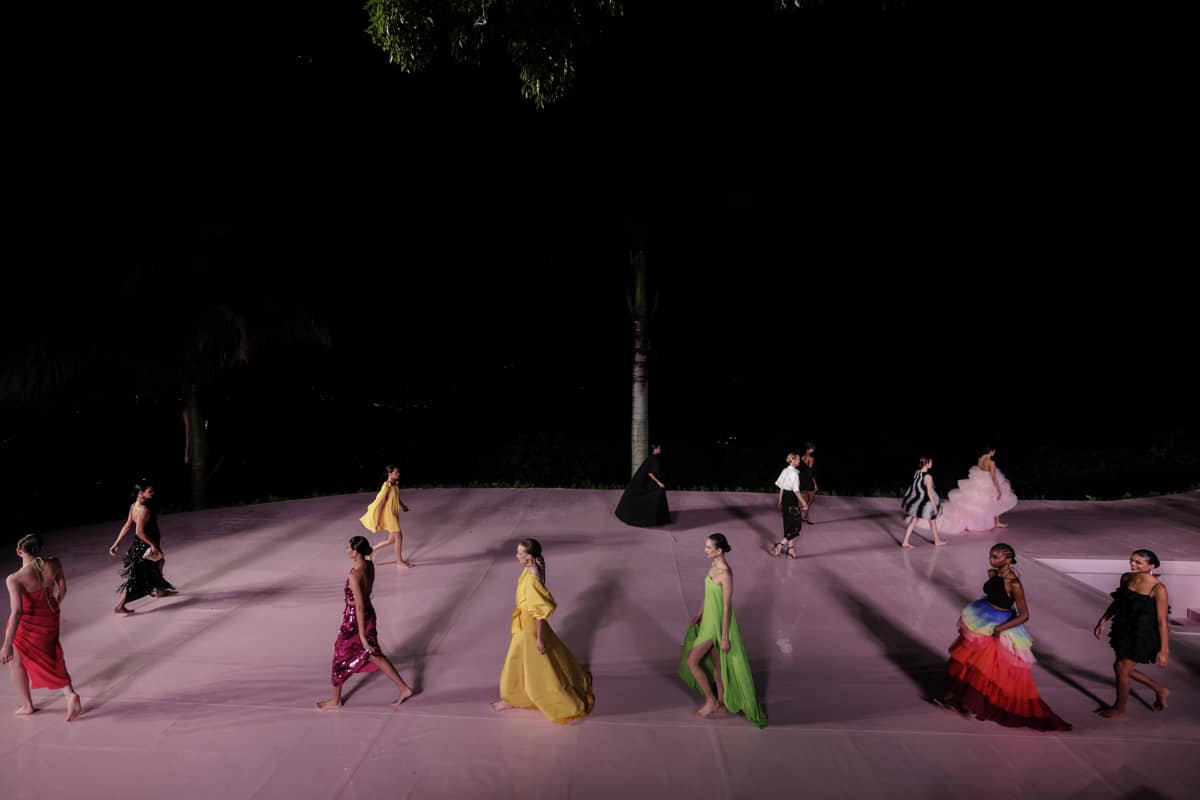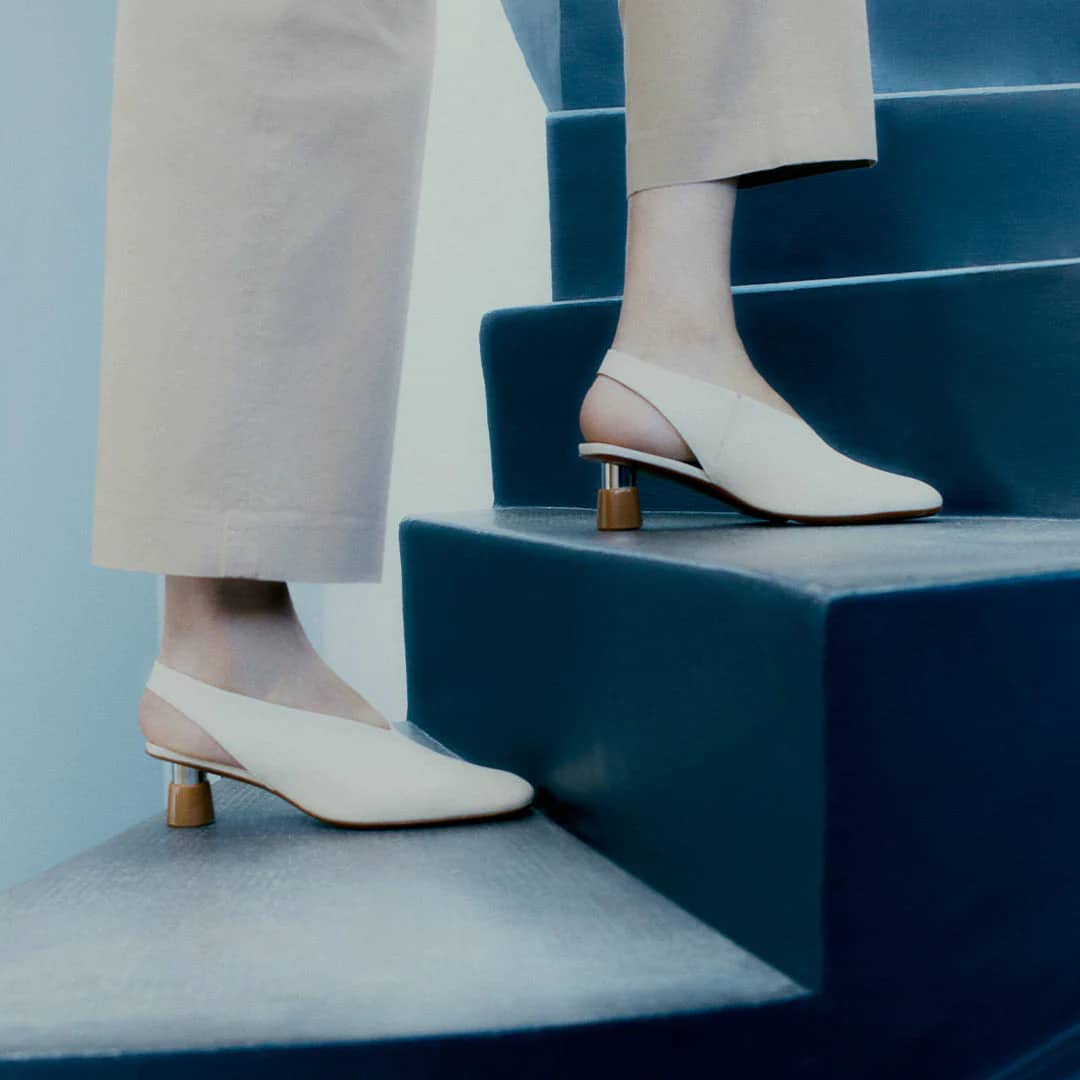For her first foray outside her New York base, the Venezuelan-born designer chose the sunny, magical setting of Rio’s Hotel Vila Santa Teresa to showcase her cruise collection. A collection with a Carioca spirit that is sure to reawaken the appeal of the luxury market in Brazil.
A colorful collection
With exclusively Brazilian models and a stage with a breathtaking view, American brand Carolina Herrera staged its first fashion show outside New York in Rio de Janeiro on Thursday June 1. The collection was inspired by the energy and joy of Rio de Janeiro.
In doing so, the American brand is following in the footsteps of the destination shows staged this season by leading luxury brands such as Versace in Cannes, Gucci in South Korea, Dior in India and Louis Vuitton in Italy.
The open-air Cruise 2024 show was held on the pool deck of Rio’s Vila Santa Teresa hotel (M Gallery), with its breathtaking view over Guanabara Bay, despite the pouring rain and the absence of the public, who took refuge inside an adjoining greenhouse for reasons of comfort and safety.

Surprised by the tropical rain, models wearing creoles and other architectural earrings adapted their gait on the catwalk, some walking barefoot, carrying their pairs of heels in one hand.
As the Puig Group’s beauty and fashion brand explained, the collection “blurs the lines between casual and elegant, day and night” to make clothes suitable for all occasions.
In the evening, silhouettes gain in volume, with a play of tulle and light fabrics, visible in mini and maxi versions throughout the show.
Highlights included a rainbow ruffled skirt adorned with sequins, and a mini-dress “cut in lake blue, kiwi green and papaya orange”.
Everywhere, we find the signature of artistic director Wes Gordon, adept at playing with textures and saturated colors, characteristics that blend perfectly with the collection’s lively, festive atmosphere.
The orchid motif is also present throughout the collection, whether in the form of delicate embroidery or as a watercolor print on organza.
Wes Gordon also paid tribute to Roberto Burle Marxau, the Brazilian artist and landscaper who designed the iconic Copacabana promenade. The result was a two-piece suit composed of hundreds of layers of hand-cut tulle, forming undulating black and white waves, a pattern that can be seen along the promenade.
Brazilian…and international ambitions
The American beauty and fashion brand has been present in Brazil since 2008.
Like jeweller Ara Vartanian, it began its Brazilian foray by opening its first boutique in the capital, Sao Paulo.
It wasn’t until 2013 – and three boutiques later – that Carolina Herrera set up its first outlet in Rio.
The choice of this city is explained by the brand’s desire to reinforce its Latin American roots while addressing the whole world. A logical move for the designer-founder, originally from Caracas, the capital of Venezuela.
As brand president Emilie Rubinfeld explains to Vogue Business, “There are many extraordinary destinations to explore – and perhaps more on the horizon”, she adds, “But [the idea of] Brazil came quickly; it’s a very important market for our fragrance business. And then the beauty of nature, the culture, the spirit, all really lend themselves to a Carolina Herrera project.”

As an added bonus, the show gave Wes Gordon – who has headed up the Maison’s artistic direction for the past 5 years – the opportunity to reappropriate Carolina Herrera’s codes, while asserting his own with vibrant colors and polka-dot patterns.
All in a very “Tropicalia Rio” spirit that would not have been denied by the Portuguese-born Brazilian singer Carmen Miranda, a fan of tutti frutti jewelry both literally and figuratively.
The aim was also to create synergies between the brand’s ready-to-wear and beauty lines, as the show rounded off a week of celebrations that also featured the launch of its new fragrance, Good Girl Blush.
For the occasion, the lights illuminating the statue of Christ the Redeemer, the symbol of the city designed by engineer Paul Landowski, perched on Mount Corcovado, took on the powder pink colors of the stiletto-shaped packaging of the fragrance.
The launch of this new fragrance was also accompanied by a travel-retail activation in the Rio de Janeiro-Antonio Carlos Jobim and Madrid-Barajas airports.
This took the form of a collection of NFTs (Non Fungible Tokens) – unique digital objects representing certificates of authenticity – with Auroboros, a collective of 3D artists involved in femtech (companies seeking technological solutions to improve women’s health and well-being).

These NFTs are token-gated, in other words, encapsulating a series of exclusive privileges for their holders, such as access to a Discord channel (a social network rallying the community of web 3 enthusiasts) or a remote masterclass with the designers themselves.
What’s more, NFT owners have access to the WOW3 program, which includes physical and virtual events, a global technology jobs platform, and a weekly podcast and newsletter.
To further democratize web3 technology in retail and appeal to the general public, the brand relies on start-up Ownest, which has developed the Owalt application. This app, embedded in an NFT vending machine (DAN), enables anyone to purchase one without having to create a wallet or pay in cryptocurrency.
Both this cruise collection and these retail activations have the potential to reinvigorate a market shunned by luxury in recent years.
The other emerging luxury market
In the BRICS family – an acronym for the high-potential markets of Brazil, Russia, India, China and South Africa – Brazil is often forgotten today, and luxury brands tend to prefer China or India.
And yet, at the beginning of the 2000s, Brazil was considered far more promising than Russia, attracting many international luxury brands such as Chanel, Dior and Louis Vuitton, as well as Cartier, Gucci, Pucci and Dolce & Gabbana. And it was at this time that Carolina Herrera chose to establish itself in Brazil.
But the recession of 2015-2016 impoverished part of the middle class, while the government then adopted protectionist measures and increased taxes on imported products.

This context has dampened hopes and confirmed the image of a destination reputed to be particularly unstable (socially and politically), not to say dangerous. The country boasts the world’s largest fleet of helicopters, second only to Colombia, as much for avoiding traffic jams as for carjacking.
As a result, between 2016 and 2018, one luxury brand in four closed its physical points of sale. This was the case for Versace, Ralph Lauren, Piaget, Lanvin and Vacheron Constantin. According to Euromonitor, the luxury goods market in Brazil contracted by 8.5% in 2017.
Against all expectations, the pandemic is changing the situation, as the inability to travel and the closure of physical points of sale are boosting the domestic market and accelerating the digital transformation of luxury brands in the country. So much so that sales are reaching record levels, surpassing 2019 pre-pandemic levels.

According to data from the Brazilian Association of Luxury Companies (ABRAEL), the local luxury goods market will grow by 50% by 2022.
The phenomenon can be explained by the combined rise of the personalized online experience, omnichannel distribution (mixing physical and online points of sale, boosted by the growth of Generation Z members – expected to account for 30% of global luxury market sales by 2030.
It has to be said that, on the physical circuit, taxes on imported products make certain products out of reach for aspirational customers (more inclined towards perfumes and cosmetics), as their prices can be 38% to 50% higher than in their country of origin.
Both financial losses and customs barriers encourage smaller luxury brands (apart from Chanel, Dior, Vuitton…) to favor e-commerce on the Brazilian market.
Read also > Alberta Ferretti braves the bad weather for her cruise show in Rimini
Featured photo : © Carolina Herrera








